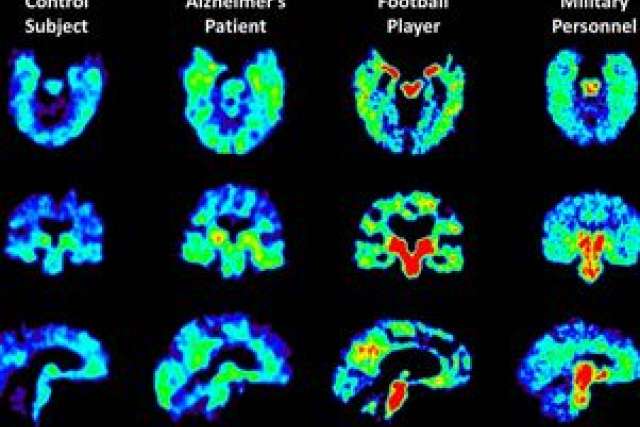FINDINGS
In a small study of military personnel who had suffered head trauma and had reported memory and mood problems, UCLA researchers found brain changes similar to those seen in retired football players who may have chronic traumatic encephalopathy, a degenerative brain disease linked to repeated blows to the head.
BACKGROUND
Chronic traumatic encephalopathy, or CTE, occurs in people who have had multiple head injuries. Recent studies and headlines have focused on former football players who exhibited symptoms such as depression, confusion and mood swings. In later stages, CTE can lead to symptoms of Alzheimer's disease and other forms of dementia. Currently, CTE can only be diagnosed after death, when examination of brain tissue reveals clumps of a protein called tau, which kills brain cells.
To aid in diagnosing CTE in living individuals, UCLA researchers are studying a molecular tracer, called FDDNP, which binds with tau as well as another abnormal protein called amyloid. The tracer, given intravenously, shows up in brain scans, pointing to the location and extent of abnormal proteins in the brain.
Previously, UCLA researchers used the tracer to study the brains of 15 former NFL players with memory and mood problems. In that study, the pattern of abnormal protein distribution in living patients was consistent with the tau distribution seen in autopsy-confirmed CTE cases.
METHOD
The current study, which builds upon the earlier research, analyzed seven military personnel (five veterans and two active duty members) who had suffered mild traumatic brain injuries and had memory or mood complaints. The subjects underwent neuropsychiatric evaluations and were given brain scans after being injected with FDDNP. The results were compared to those of the 15 previously studied retired football players, as well as 24 people with Alzheimer's dementia and 28 people without cognitive problems, for comparison.
IMPACT
The location and quantity of the tracer in the brains of the military personnel were similar to that seen in retired football players and distinct from the distribution patterns seen in people with Alzheimer's disease or in healthy individuals.
Larger studies using FDDNP and brain scans in people at risk for chronic traumatic encephalopathy are needed to confirm the usefulness of FDDNP as a diagnostic tool. The ability to diagnose chronic traumatic encephalopathy in living individuals would help scientists observe the progression of the disease, develop treatments and quantify the scope of CTE among different populations, such as military veterans.
AUTHORS
Dr. Gary Small, a professor of psychiatry and biobehavioral sciences at UCLA and director of the Longevity Center at UCLA's Semel Institute for Neuroscience and Human Behavior, is the study's senior author. Co-first authors are Dr. Stephen Chen and Dr. Prabha Siddarth, both of UCLA. Other authors are Jorge Barrio, Natacha Emerson, Chris Giza, Sung-Cheng Huang, Jie Liu, Jacqueline Martinez, David Merrill, Nagichettiar Satyamurthy and Koon-Pong Wong, all of UCLA; Robert Fitzsimmons of Fitzsimmons Law Offices in Wheeling, West Virginia; Julian Bailes co-director of NorthShore University HealthSystem's Neurological Institute in Evanston, Illinois; and Bennet Omalu of UC Davis.
JOURNAL
The study appeared July 17 in the Journal of Alzheimer's Disease.
FUNDING
This study was supported by the Fran and Ray Stark Foundation Fund for Alzheimer's Disease Research; the Parlow-Solomon and Plot Professorships; Bob and Marion Wilson; the Ahmanson Foundation; the National Institutes of Health; and the Department of Energy.
The FDDNP tracer is intellectual property owned by UCLA and licensed to TauMark LLC. Barrio, Huang, Omalu, Satyamurthy and Small are co-inventors of the marker. Barrio, Fitzsimmons, Huang, Satyamurthy and Small have a financial interest in TauMark. Other disclosures are listed in the study.



